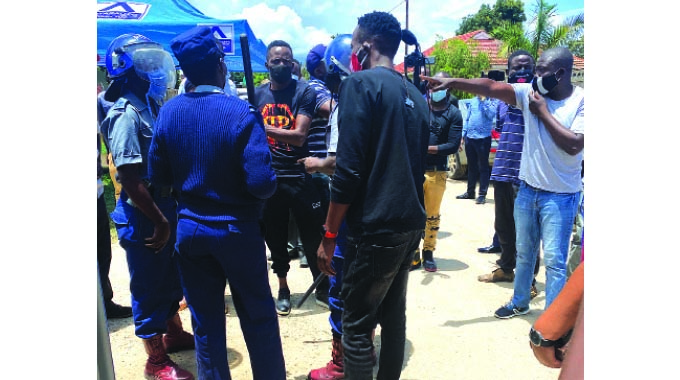Editorial Comment: Long journey to vaccine roll-out has started

Zimbabwe started mass vaccination yesterday, a programme that brings hope that we can eventually free ourselves of Covid-19, but also a programme that will take time and will need to be backed up by strict adherence to all the practices that have so far kept our infection rates within the limits that our health systems can cope with.
It is going to be a long journey, but at least we are taking the first step. It is also a journey that is going to require a great deal of patience, a great deal of co-operation and a great deal of trust.
To give some idea of the scale of the programme we need to look at the roll-out using the 200 000 doses, enough for the two jabs each for 100 000 people.
That sound like a lot of people, and it is; in fact, only the five largest urban centres hold more. And yet this first delivery is enough for just one percent of the 10 million people we need to vaccinate to get a reasonable degree of coverage.
Or, looking at it in another way, another 99 plane loads of vaccine need to be flown in as Zimbabwe gets its share of the global output of vaccines, and already some voices in the developing world have been sounding warnings that some vaccine producers want to satisfy their home country demand first.
We are fortunate that China, despite having the largest vaccination programme on the planet, is willing to share.
There will also be major planning required across Zimbabwe as the programme rolls out. The first stage of phase one, the stage that started yesterday, is in all ways the easiest.
This stage targets all our health workers plus other critical frontline workers who are certain to come into contact with a lot of sick and infected people. These are the people most at risk of infection since they deal with infected people daily.
But all this group is known by name and workplace to the programme organisers so the exact number of doses can be allocated to each vaccination point and those to be vaccinated at each point can be individually called in at the right time on the right day.
And here we are not talking about major hospitals, but also how many doses to be sent to Chiredzi, how many to Gokwe, how many to Tsholotsho. As we move into stage two of the first phase, it becomes a bit harder to predict how many doses are needed at each vaccination point and how queues, unnecessary trips and the like can be avoided.
This second stage targets the elderly, eventually all over 60s, and those with a listed chronic condition. These are the people most at risk at developing serious complications that can be fatal if they are infected. The Ministry of Health and Child Care and ZimStat between them can, however, make quite good estimates of how many in each priority group live in the catchment area of each vaccination centre.
ZimStat, extrapolating from the 2012 census data, can give a good estimate of the population in each catchment zone and can give an even better estimate of the numbers in the older age groups since they were physically counted when they were nine years younger, and the totals can be corrected by applying the crude death rates for each age cohort.
The Ministry has the data that allows it to estimate what percentage of the population, again corrected for age groups, lives with what are regarded as the dangerous chronic conditions, such as diabetes or hypertension. So estimating the number of doses for this stage, or more likely each sub-stage, at each vaccination centre is possible.
But then a system will be needed to prevent say 100 000 people in Harare standing in the city queues at 8am on the first day.
Obviously they need to be divided into small groups in some way, possibly by age, condition and surname. This will require active co-operation from the media to ensure that everyone knows what day, and even roughly what time, they should turn up at a given vaccination centre for their area.
However, we manage roll-outs quite well. Every year, for example, more than 250 000 children write Zimsec examinations and we manage to have those millions of exam papers in the right place at the right time, with the right children walking into each centre. It is just a matter of logistics and organisation.
Identification cards can be proof of age and while many people do not have certificates for their chronic condition, or even a copy of a prescription, they can always bring their bag of medicines labelled with their name to show they have the listed medical condition.
There have been concerns that some people might not want to be vaccinated, and considering the way anti-vaxxers can spread their ignorance over social media, to add to understandable concerns over anything new, this has to be addressed. Fortunately almost every church and religious leader has backed vaccination. All health professionals back vaccination. And the World Health Organisation has given its enthusiastic support.
The Minister of Health and Child Care, Vice President Constantino Chiwenga himself, provided leadership by standing first in line. And to quell possible social media criticism that he jumped the queue, he seems to qualify for the first phase.
Although he is not a health professional, as Health Minister he has to associate with the at-risk professionals, visit health centres and generally is at roughly the same level of risk.
Although he is more active than most people half his age, he is still labelled as “elderly” by his younger professionals. And as it is a matter of record that he has had spells in hospital for serious life-threatening illnesses, it is probable that he lives with one of the listed conditions.
While yesterday was a good day, that first glimmer in the eastern sky after a dark night, it will take time for 10 million of us to get two jabs each, so everyone has to remain vigilant and continue to wear masks out of the house, maintain social distancing, refrain from any unnecessary trips, wash and sanitise their hands frequently and submit to temperature checks and employer-organised testing. It is going to be a long day until we can all relax in the evening after a job well done.










Comments